Shaona Ghosh
NVIDIA Nemotron Nano 2: An Accurate and Efficient Hybrid Mamba-Transformer Reasoning Model
Aug 21, 2025



Abstract:We introduce Nemotron-Nano-9B-v2, a hybrid Mamba-Transformer language model designed to increase throughput for reasoning workloads while achieving state-of-the-art accuracy compared to similarly-sized models. Nemotron-Nano-9B-v2 builds on the Nemotron-H architecture, in which the majority of the self-attention layers in the common Transformer architecture are replaced with Mamba-2 layers, to achieve improved inference speed when generating the long thinking traces needed for reasoning. We create Nemotron-Nano-9B-v2 by first pre-training a 12-billion-parameter model (Nemotron-Nano-12B-v2-Base) on 20 trillion tokens using an FP8 training recipe. After aligning Nemotron-Nano-12B-v2-Base, we employ the Minitron strategy to compress and distill the model with the goal of enabling inference on up to 128k tokens on a single NVIDIA A10G GPU (22GiB of memory, bfloat16 precision). Compared to existing similarly-sized models (e.g., Qwen3-8B), we show that Nemotron-Nano-9B-v2 achieves on-par or better accuracy on reasoning benchmarks while achieving up to 6x higher inference throughput in reasoning settings like 8k input and 16k output tokens. We are releasing Nemotron-Nano-9B-v2, Nemotron-Nano12B-v2-Base, and Nemotron-Nano-9B-v2-Base checkpoints along with the majority of our pre- and post-training datasets on Hugging Face.
Surfacing Semantic Orthogonality Across Model Safety Benchmarks: A Multi-Dimensional Analysis
May 23, 2025Abstract:Various AI safety datasets have been developed to measure LLMs against evolving interpretations of harm. Our evaluation of five recently published open-source safety benchmarks reveals distinct semantic clusters using UMAP dimensionality reduction and kmeans clustering (silhouette score: 0.470). We identify six primary harm categories with varying benchmark representation. GretelAI, for example, focuses heavily on privacy concerns, while WildGuardMix emphasizes self-harm scenarios. Significant differences in prompt length distribution suggests confounds to data collection and interpretations of harm as well as offer possible context. Our analysis quantifies benchmark orthogonality among AI benchmarks, allowing for transparency in coverage gaps despite topical similarities. Our quantitative framework for analyzing semantic orthogonality across safety benchmarks enables more targeted development of datasets that comprehensively address the evolving landscape of harms in AI use, however that is defined in the future.
* 6th International Conference on Advanced Natural Language Processing (AdNLP 2025), May 17 ~ 18, 2025, Zurich, Switzerland
Nemotron-H: A Family of Accurate and Efficient Hybrid Mamba-Transformer Models
Apr 10, 2025

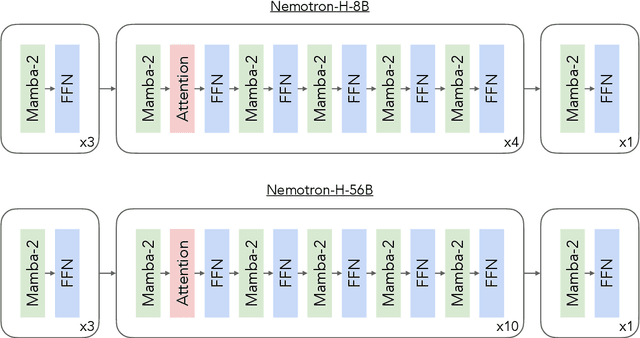
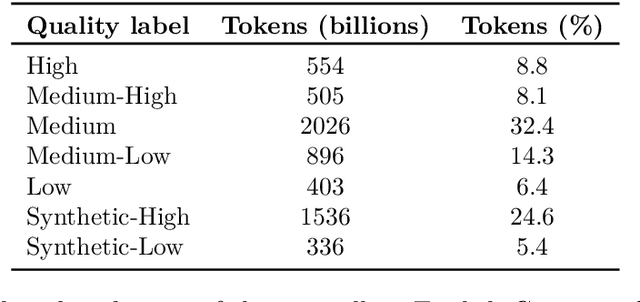
Abstract:As inference-time scaling becomes critical for enhanced reasoning capabilities, it is increasingly becoming important to build models that are efficient to infer. We introduce Nemotron-H, a family of 8B and 56B/47B hybrid Mamba-Transformer models designed to reduce inference cost for a given accuracy level. To achieve this goal, we replace the majority of self-attention layers in the common Transformer model architecture with Mamba layers that perform constant computation and require constant memory per generated token. We show that Nemotron-H models offer either better or on-par accuracy compared to other similarly-sized state-of-the-art open-sourced Transformer models (e.g., Qwen-2.5-7B/72B and Llama-3.1-8B/70B), while being up to 3$\times$ faster at inference. To further increase inference speed and reduce the memory required at inference time, we created Nemotron-H-47B-Base from the 56B model using a new compression via pruning and distillation technique called MiniPuzzle. Nemotron-H-47B-Base achieves similar accuracy to the 56B model, but is 20% faster to infer. In addition, we introduce an FP8-based training recipe and show that it can achieve on par results with BF16-based training. This recipe is used to train the 56B model. All Nemotron-H models will be released, with support in Hugging Face, NeMo, and Megatron-LM.
Aegis2.0: A Diverse AI Safety Dataset and Risks Taxonomy for Alignment of LLM Guardrails
Jan 15, 2025



Abstract:As Large Language Models (LLMs) and generative AI become increasingly widespread, concerns about content safety have grown in parallel. Currently, there is a clear lack of high-quality, human-annotated datasets that address the full spectrum of LLM-related safety risks and are usable for commercial applications. To bridge this gap, we propose a comprehensive and adaptable taxonomy for categorizing safety risks, structured into 12 top-level hazard categories with an extension to 9 fine-grained subcategories. This taxonomy is designed to meet the diverse requirements of downstream users, offering more granular and flexible tools for managing various risk types. Using a hybrid data generation pipeline that combines human annotations with a multi-LLM "jury" system to assess the safety of responses, we obtain Aegis 2.0, a carefully curated collection of 34,248 samples of human-LLM interactions, annotated according to our proposed taxonomy. To validate its effectiveness, we demonstrate that several lightweight models, trained using parameter-efficient techniques on Aegis 2.0, achieve performance competitive with leading safety models fully fine-tuned on much larger, non-commercial datasets. In addition, we introduce a novel training blend that combines safety with topic following data.This approach enhances the adaptability of guard models, enabling them to generalize to new risk categories defined during inference. We plan to open-source Aegis 2.0 data and models to the research community to aid in the safety guardrailing of LLMs.
Towards Inference-time Category-wise Safety Steering for Large Language Models
Oct 02, 2024


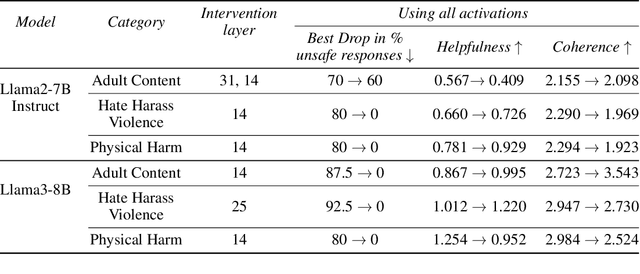
Abstract:While large language models (LLMs) have seen unprecedented advancements in capabilities and applications across a variety of use-cases, safety alignment of these models is still an area of active research. The fragile nature of LLMs, even models that have undergone extensive alignment and safety training regimes, warrants additional safety steering steps via training-free, inference-time methods. While recent work in the area of mechanistic interpretability has investigated how activations in latent representation spaces may encode concepts, and thereafter performed representation engineering to induce such concepts in LLM outputs, the applicability of such for safety is relatively under-explored. Unlike recent inference-time safety steering works, in this paper we explore safety steering of LLM outputs using: (i) category-specific steering vectors, thereby enabling fine-grained control over the steering, and (ii) sophisticated methods for extracting informative steering vectors for more effective safety steering while retaining quality of the generated text. We demonstrate our exploration on multiple LLMs and datasets, and showcase the effectiveness of the proposed steering method, along with a discussion on the implications and best practices.
Nemotron-4 340B Technical Report
Jun 17, 2024



Abstract:We release the Nemotron-4 340B model family, including Nemotron-4-340B-Base, Nemotron-4-340B-Instruct, and Nemotron-4-340B-Reward. Our models are open access under the NVIDIA Open Model License Agreement, a permissive model license that allows distribution, modification, and use of the models and its outputs. These models perform competitively to open access models on a wide range of evaluation benchmarks, and were sized to fit on a single DGX H100 with 8 GPUs when deployed in FP8 precision. We believe that the community can benefit from these models in various research studies and commercial applications, especially for generating synthetic data to train smaller language models. Notably, over 98% of data used in our model alignment process is synthetically generated, showcasing the effectiveness of these models in generating synthetic data. To further support open research and facilitate model development, we are also open-sourcing the synthetic data generation pipeline used in our model alignment process.
AEGIS: Online Adaptive AI Content Safety Moderation with Ensemble of LLM Experts
Apr 09, 2024



Abstract:As Large Language Models (LLMs) and generative AI become more widespread, the content safety risks associated with their use also increase. We find a notable deficiency in high-quality content safety datasets and benchmarks that comprehensively cover a wide range of critical safety areas. To address this, we define a broad content safety risk taxonomy, comprising 13 critical risk and 9 sparse risk categories. Additionally, we curate AEGISSAFETYDATASET, a new dataset of approximately 26, 000 human-LLM interaction instances, complete with human annotations adhering to the taxonomy. We plan to release this dataset to the community to further research and to help benchmark LLM models for safety. To demonstrate the effectiveness of the dataset, we instruction-tune multiple LLM-based safety models. We show that our models (named AEGISSAFETYEXPERTS), not only surpass or perform competitively with the state-of-the-art LLM-based safety models and general purpose LLMs, but also exhibit robustness across multiple jail-break attack categories. We also show how using AEGISSAFETYDATASET during the LLM alignment phase does not negatively impact the performance of the aligned models on MT Bench scores. Furthermore, we propose AEGIS, a novel application of a no-regret online adaptation framework with strong theoretical guarantees, to perform content moderation with an ensemble of LLM content safety experts in deployment
CantTalkAboutThis: Aligning Language Models to Stay on Topic in Dialogues
Apr 04, 2024Abstract:Recent advancements in instruction-tuning datasets have predominantly focused on specific tasks like mathematical or logical reasoning. There has been a notable gap in data designed for aligning language models to maintain topic relevance in conversations - a critical aspect for deploying chatbots to production. We introduce the CantTalkAboutThis dataset to help language models remain focused on the subject at hand during task-oriented interactions. It consists of synthetic dialogues on a wide range of conversation topics from different domains. These dialogues are interspersed with distractor turns that intentionally divert the chatbot from the predefined topic. Fine-tuning language models on this dataset helps make them resilient to deviating from the role assigned and improves their ability to maintain topical coherence compared to general-purpose instruction-tuned LLMs like GPT-4-turbo and Mixtral-Instruct. Additionally, preliminary observations suggest that training models on this dataset also enhance their performance on fine-grained instruction following tasks.
Joint Learning of Portrait Intrinsic Decomposition and Relighting
Jun 22, 2021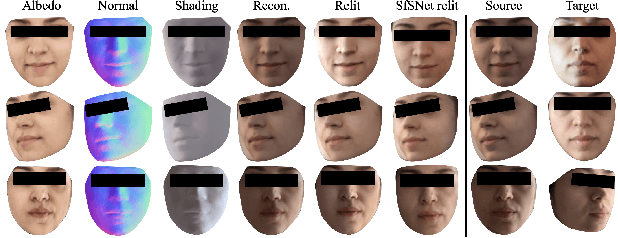
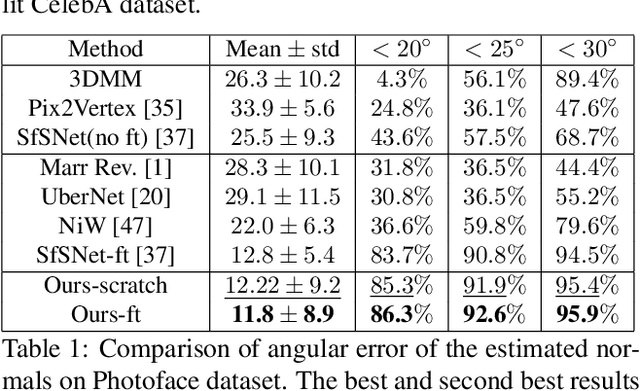

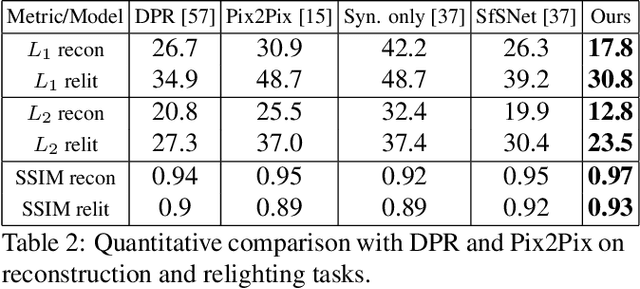
Abstract:Inverse rendering is the problem of decomposing an image into its intrinsic components, i.e. albedo, normal and lighting. To solve this ill-posed problem from single image, state-of-the-art methods in shape from shading mostly resort to supervised training on all the components on either synthetic or real datasets. Here, we propose a new self-supervised training paradigm that 1) reduces the need for full supervision on the decomposition task and 2) takes into account the relighting task. We introduce new self-supervised loss terms that leverage the consistencies between multi-lit images (images of the same scene under different illuminations). Our approach is applicable to multi-lit datasets. We apply our training approach in two settings: 1) train on a mixture of synthetic and real data, 2) train on real datasets with limited supervision. We show-case the effectiveness of our training paradigm on both intrinsic decomposition and relighting and demonstrate how the model struggles in both tasks without the self-supervised loss terms in limited supervision settings. We provide results of comprehensive experiments on SfSNet, CelebA and Photoface datasets and verify the performance of our approach on images in the wild.
Neural Networks for Text Correction and Completion in Keyboard Decoding
Sep 19, 2017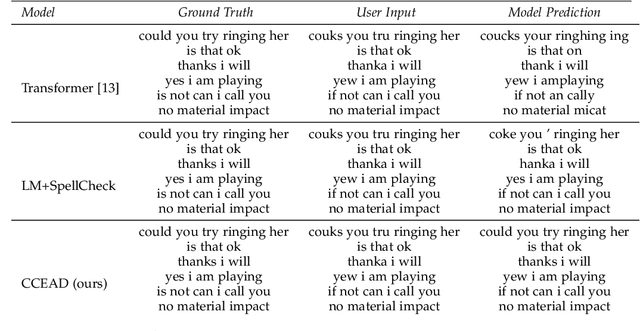
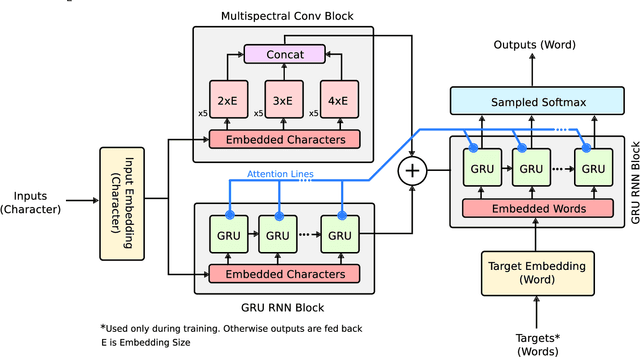

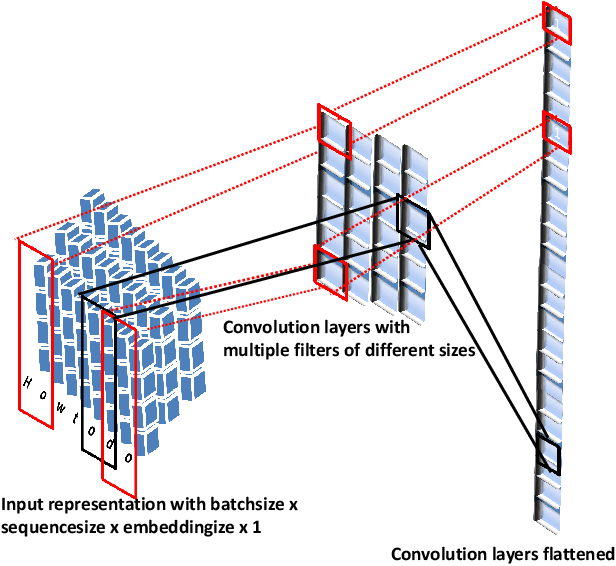
Abstract:Despite the ubiquity of mobile and wearable text messaging applications, the problem of keyboard text decoding is not tackled sufficiently in the light of the enormous success of the deep learning Recurrent Neural Network (RNN) and Convolutional Neural Networks (CNN) for natural language understanding. In particular, considering that the keyboard decoders should operate on devices with memory and processor resource constraints, makes it challenging to deploy industrial scale deep neural network (DNN) models. This paper proposes a sequence-to-sequence neural attention network system for automatic text correction and completion. Given an erroneous sequence, our model encodes character level hidden representations and then decodes the revised sequence thus enabling auto-correction and completion. We achieve this by a combination of character level CNN and gated recurrent unit (GRU) encoder along with and a word level gated recurrent unit (GRU) attention decoder. Unlike traditional language models that learn from billions of words, our corpus size is only 12 million words; an order of magnitude smaller. The memory footprint of our learnt model for inference and prediction is also an order of magnitude smaller than the conventional language model based text decoders. We report baseline performance for neural keyboard decoders in such limited domain. Our models achieve a word level accuracy of $90\%$ and a character error rate CER of $2.4\%$ over the Twitter typo dataset. We present a novel dataset of noisy to corrected mappings by inducing the noise distribution from the Twitter data over the OpenSubtitles 2009 dataset; on which our model predicts with a word level accuracy of $98\%$ and sequence accuracy of $68.9\%$. In our user study, our model achieved an average CER of $2.6\%$ with the state-of-the-art non-neural touch-screen keyboard decoder at CER of $1.6\%$.
 Add to Chrome
Add to Chrome Add to Firefox
Add to Firefox Add to Edge
Add to Edge